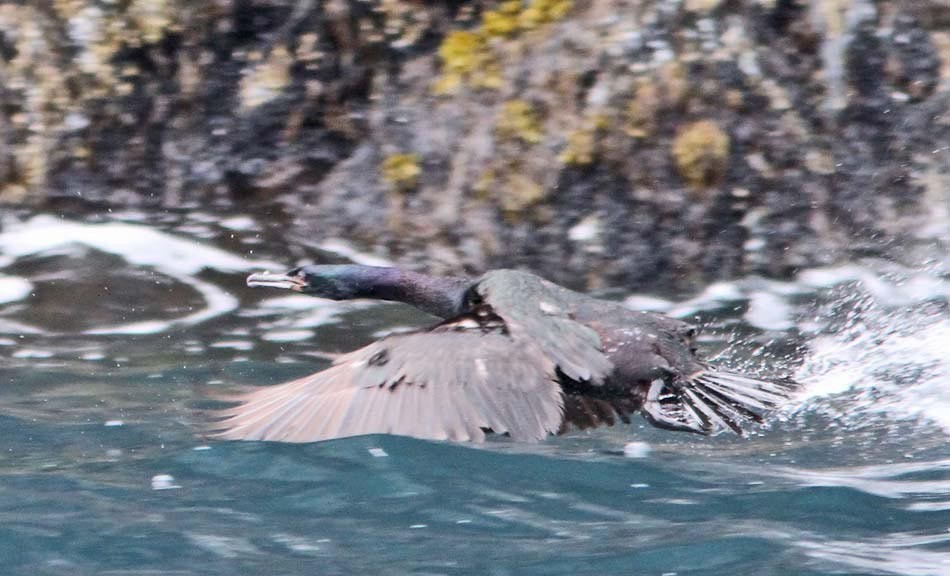Red-faced Cormorant
A species of Typical Cormorants and Shags Scientific name : Urile urile Genus : Typical Cormorants and Shags
Red-faced Cormorant, A species of Typical Cormorants and Shags
Botanical name: Urile urile
Genus: Typical Cormorants and Shags
Content
Description General Info
 Photo By Don Roberson
Photo By Don Roberson Description
The red-faced cormorant (Phalacrocorax urile), red-faced shag or violet shag, is a bird species of the family Phalacrocoracidae. Its range spans from the eastern tip of Hokkaidō in Japan, via the Kuril Islands, the southern tip of the Kamchatka Peninsula and the Aleutian Arc to the Alaska Peninsula and Gulf of Alaska. The red-faced cormorant is closely related to the pelagic cormorant P. pelagicus, which has a similar range, and like the pelagic cormorant is placed by some authors (e.g. Johnsgaard) in a genus Leucocarbo. Where it nests alongside the pelagic cormorant, the red-faced cormorant generally breeds the more successfully of the two species, and it is currently increasing in numbers, at least in the easterly parts of its range. It is however listed as being of conservation concern, partly because relatively little is so far known about it. The adult bird has glossy plumage that is a deep greenish blue in color, becoming purplish or bronze on the back and sides. In breeding condition it has a double crest, and white plumes on the flanks, neck and rump, and the bare facial skin of the lores and around the eyes is a bright orange or red, giving the bird its name; although the coloration is less vivid outside the breeding season, the red facial skin is enough to distinguish it from the otherwise rather similar pelagic cormorant. Its legs and feet are brownish black. Its wings range from 25 to 29 cm in extent, with females having on average about 5 cm shorter wings. Adults weigh between 1.5 and 2.3 kg, with females averaging 350 g less than males. Analysis of stomach contents suggests that the red-faced cormorant is mainly a bottom feeder, taking cottids especially. Adults have few predators, though river otters may attempt to take them, as will corvids of various species, bald eagles and golden eagles. Gulls and corvids are common predators on eggs and chicks. 
Size
41 - 81 cm
Nest Placement
Cliff
Clutch Size
2 - 3 eggs
Incubation Period
1 brood
Number of Broods
31 - 38 days
Nestling Period
40 - 50 days
Feeding Habits
Red-faced Cormorant primarily consume benthic fish, diving with powerful webbed feet to forage among seafloor rocks. Smaller prey is swallowed underwater; larger prey is softened at the surface. They forage alone, occasionally in mixed species flocks near their nests (1-2 miles). Diet includes marine worms, crustaceans, mollusks, herring, smelt, sandlance, sculpin, flatfish, and scorpionfish.
Habitat
Red-faced Cormorant typically inhabits marine environments near islands and rugged coastlines in the North Pacific. These birds are found nesting on steep, inaccessible cliffs and ledges, often alongside various seabird species. Preferring areas with minimal human disturbance, red-faced Cormorant roosts on bare, rocky shorelines. During foraging, this species stays within inshore waters, generally no deeper than 200 meters and within 16 kilometers from the coast. Seasonal movements of red-faced Cormorant are constrained to ice-free coastal zones without true migration.
Nest Behavior
When nesting, red-faced Cormorant exhibits a specific sequence beginning with nest building, followed by egg-laying, and engaging in diligent parental care to ensure the survival of the eggs and subsequent young.
Nest Characteristics
Red-faced Cormorant builds oval-shaped bowl nests on broad ledges of steep cliffs along marine islands and coastlines. The nests, constructed with grass, seaweed, mosses, sticks, feathers, and bonded by guano, measure approximately 20 inches in length, 16 inches wide, and 6 inches tall.
Dite type
Piscivorous
General Info
Feeding Habits
Bird food type
Behavior
Red-faced Cormorant's typical day revolves around foraging for food in nearby waters and maintaining their nesting sites. They display more solitary habits compared to their cormorant relatives, often nesting in sparse pairs rather than larger colonies. With a strong sense of territory, males arrive first at the nesting cliffs, engaging in elaborate displays to attract mates and deter competitors. Activities like wing-waving and showing their distinct white flank patches are common. Red-faced Cormorant construct basic nests and fiercely defend them from rivals through intimidation and physical confrontation, especially when subadults are present. Their interaction with the environment is marked by an early claim of nest ledges in spring and a readiness to engage in combat to secure these vital spaces.

 Photo By Don Roberson
Photo By Don Roberson Scientific Classification
Phylum
Chordates Class
Birds Order
Gannets and Relatives Family
Cormorants Species
Red-faced Cormorant